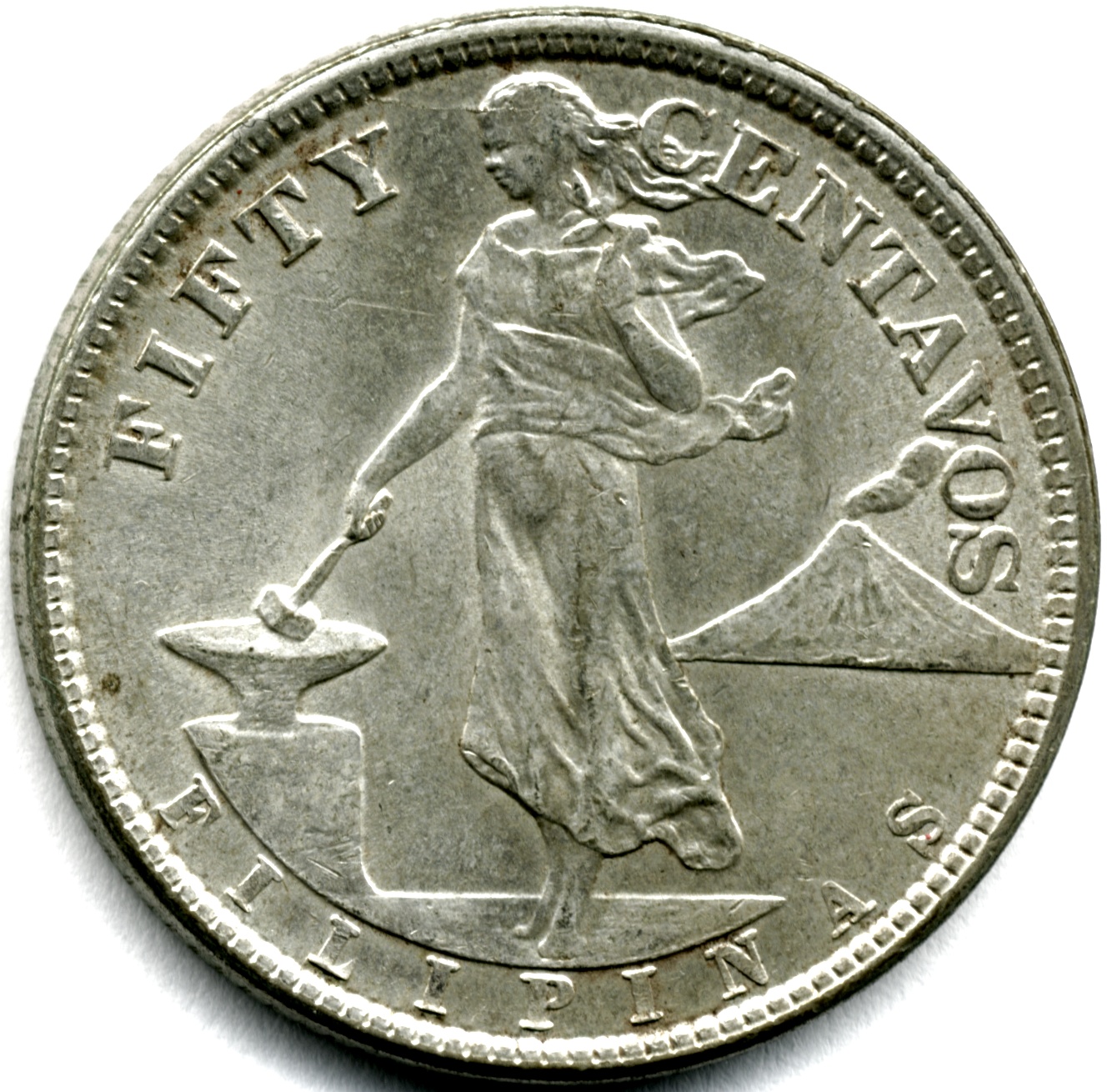Philippine Fifty-centavo Coin on:
[Wikipedia]
[Google]
[Amazon]
The Philippine fifty-centavo coin ( fil, limampung sentimo) (50¢) was a denomination of Philippine currency. It was minted for the Philippines from 1864 to 1994 and was demonetized in 1998.
 Prior to 1864, coins valued at 1/2 a '' Spanish dollar (or peso)'' or '' four reales'' issued by
Prior to 1864, coins valued at 1/2 a '' Spanish dollar (or peso)'' or '' four reales'' issued by
 In 1903 the 50-centavo coin equivalent to 1/4th a
In 1903 the 50-centavo coin equivalent to 1/4th a
Error Coin’s error , Pinoy Numismatist Network
/ref>
History
Spanish administration
 Prior to 1864, coins valued at 1/2 a '' Spanish dollar (or peso)'' or '' four reales'' issued by
Prior to 1864, coins valued at 1/2 a '' Spanish dollar (or peso)'' or '' four reales'' issued by Spain
, image_flag = Bandera de España.svg
, image_coat = Escudo de España (mazonado).svg
, national_motto = ''Plus ultra'' (Latin)(English: "Further Beyond")
, national_anthem = (English: "Royal March")
, i ...
and Spanish America were generally accepted in the Philippines for half a peso. The half-peso coin was considered as the successor to the pre-Hispanic silver denomination ''rupee'' or ''rupiah'', locally called ''salapi''. In 1864 a silver 50-centimo coin was issued specifically for the Philippines weighing 12.98 grams of 0.9 fine silver (reduced to 0.835 fine after 1881).
United States administration
 In 1903 the 50-centavo coin equivalent to 1/4th a
In 1903 the 50-centavo coin equivalent to 1/4th a U.S. dollar
The United States dollar ( symbol: $; code: USD; also abbreviated US$ or U.S. Dollar, to distinguish it from other dollar-denominated currencies; referred to as the dollar, U.S. dollar, American dollar, or colloquially buck) is the officia ...
was minted for the Philippines, weighing 13.48 grams of 0.9 fine silver. Its specifications were reduced from 1907 to 10.0 grams of 0.75 fine silver; this was minted until 1945.
Independence
* ''English Series
The English Series were Banknotes of the Philippine peso, Philippine banknotes and Coins of the Philippine peso, coins that circulated from 1949 to 1969. It was the first banknote and coin series of the newly established Bangko Sentral ng Pilipinas ...
:'' In 1958, minting of the centavo resumed with another coat of arms on the reverse. The inscription around the coat of arms was changed to 'Central Bank of the Philippines'.
* ''Pilipino Series The Pilipino Series banknotes is the name used to refer to Philippines, Philippine Banknotes of the Philippine peso, banknotes and Coins of the Philippine peso, coins issued by the Bangko Sentral ng Pilipinas, Central Bank of the Philippines from 19 ...
:'' In 1969, the coin featured the Tagalog language for the first time. Its obverse featured Marcelo H. del Pilar in profile to the left, a Filipino
Filipino may refer to:
* Something from or related to the Philippines
** Filipino language, standardized variety of 'Tagalog', the national language and one of the official languages of the Philippines.
** Filipinos, people who are citizens of th ...
writer, lawyer, journalist, and freemason
Freemasonry or Masonry refers to fraternal organisations that trace their origins to the local guilds of stonemasons that, from the end of the 13th century, regulated the qualifications of stonemasons and their interaction with authorities ...
of the Philippine Revolution during the late 19th century. The inscription around the shield of the Coat of arms of the Philippines
The coat of arms of the Philippines ( fil, Sagisag ng Pilipinas; es, Escudo de Filipinas) features the eight-rayed sun of the Philippines with each ray representing the eight provinces (Batangas, Bulacan, Cavite, Manila, Laguna (province), La ...
on its reverse read 'Republika ng Pilipinas', however, mintage of this coin was discontinued with the introduction of the '' Ang Bagong Lipunan Series''.
*1983: BSP reintroduces 50¢ coins as part of the ''Flora and Fauna Series''. The coin has the profile of Marcelo del Pilar on the obverse and the ''Pithecophaga jefferyi
The Philippine eagle (''Pithecophaga jefferyi''), also known as the monkey-eating eagle or great Philippine eagle, is a critically endangered species of eagle of the family Accipitridae which is endemic to forests in the Philippines. It has br ...
'' (Philippine eagle) on the reverse.
*1991: ''Improved Flora and Fauna Series'', features the same designs on both the obverse and reverse, but was minted in brass
Brass is an alloy of copper (Cu) and zinc (Zn), in proportions which can be varied to achieve different mechanical, electrical, and chemical properties. It is a substitutional alloy: atoms of the two constituents may replace each other with ...
instead of Copper-Nickel.
*1995: The fifty-centavo coin was not included when the ''BSP Series'' was introduced.
*1998: The 50¢ coin and other coins in the original ''Flora and Fauna'' and ''Improved Flora and Fauna Series'' was withdrawn, making the coin officially demonetized.
Version history
Errors
Some of the coins of the ''Flora and Fauna Series'' had an error; in the fifty-centavo coin, the text was "Pitecobhaga jefferyi" instead of "Pitecophaga jefferyi", It was later replaced by the Bangko Sentral ng Pilipinas./ref>
References
{{Philippine peso history Obsolete denominations of the Philippine peso Philippines currency history Fifty-cent coins